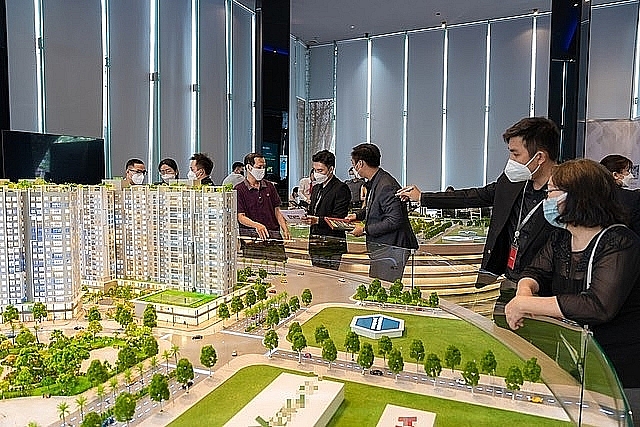 |
| Congested capital flow into real estate will reduce market heat. Photo: T.D |
Facing many difficulties
Dr. Can Van Luc, chief economist at BIDV, a member of the Advisory Council – National Monetary Policy, said that recently, the phenomenon of capital accumulation for businesses is a painful thing.
Currently, about 30-40% of real estate, construction and installation businesses are owed each other an amount of about VND60,000 billion. Previously they extended each other 45 days but now it has been up to 90 days. Therefore, cash flow slows down and this is a difficulty for construction and real estate businesses.
If the capital flow into real estate is blocked, it will reduce the heat of the market and the market is actually quiet. Besides, the market has an imbalance between supply and demand for real estate (supply cannot increase, demand does not decrease), projects may be unfinished, liquidity in the real estate market decreases, and bad debts increase while securities decreased accordingly, reducing the economic recovery momentum.
According to Dr. Can Van Luc, Vietnam still has a lot of room to develop housing credit because many segments are still short of supply, and the construction sector continues to develop.
From now to 2030, Vietnam needs about VND700,000 billion each year.
Therefore, it is necessary to develop a more balanced and harmonious financial market; create development but still control risks, take advantage of new opportunities; direct capital flow, not blocking, pay attention to financial system risks; focus on regulating the supply-demand of real estate.
Vo Thi Khanh Trang, Deputy Director of Savills Vietnam Research, said that in the context of credit tightening, only real investors with financial resources and sustainable development can continue to survive in the market. While investors depend on loans and do not have a sustainable development process, they will face many difficulties.
In terms of homebuyers, Khanh Trang said that the credit squeeze can reduce the group of speculative, surfing and non-residential buyers, thereby helping homebuyers with real needs get closer to the real estate market. In addition, many investors, in the face of rising land use costs and raw material prices, will consider switching to the affordable and social housing segment, which is experiencing a decrease in supply, contributing to helping market equilibrium.
According to Vo Hong Thang, Deputy Director of Research and Development, DKRA Real Estate Services Group, it is forecast that in the last 6 months of the year, the general demand, as well as market liquidity, may continue to be affected if the bank’s real estate credit squeeze has not been resolved in a timely manner. In particular, credit control strongly affects the psychology of first-time homebuyers. Therefore, the condominium market will enter a strong screening in the second half of the year.
Manage to find capital
Faced with the above situation, recently, the Ho Chi Minh City Real Estate Association (HoREA) has proposed to the State Bank to consider increasing the ceiling of credit outstanding in 2022 by 1-2% to create favorable conditions for real estate businesses with a feasible project, a reputable brand name, and collateral to access credit loans.
According to HoREA, in the context of credit control, the real estate market in Ho Chi Minh City has been affected. The selling rate in the second quarter to the middle of the third quarter of 2022 decreased due to rising interest rates and difficult access to capital, but selling prices still peaked.
However, according to many experts, businesses and real estate investors should not expect too much credit easing, but should find ways to reduce dependence on bank credit such as capital from bond mobilization, speeding up the diversification of domestic and foreign loans, creating favorable conditions for buyers by adjusting payment terms in line with credit limits from banks.
Issuing shares to foreign investment funds is the direction chosen by some branded enterprises. Recently, Novaland announced receiving an investment of US$250 million from an investment fund group led by Warburg Pincus. The amount is expected to be allocated to increase the land bank and develop Novaland’s projects in strategic locations, taking advantage of the gradually improving infrastructure in the South.
Similarly, Hung Thinh Land also entered the international capital market with the deal to raise US$103 million from Dragon Capital and VinaCapital to complement projects ranging from affordable to resort complexes. Or as Nam Long Group also mobilized VND1,000 billion from issuing bonds to International Finance Company (IFC) with a fixed interest rate of 9.35%/year for 7 years. The purpose of this mobilization is to invest in phase 2 of the Waterpoint project (Long An).
Phung Quang Hai, General Director of Khai Hoan Land Group Joint Stock Company, said that in recent years, enterprises have focused on increasing internal resources through capital raising rather than mobilizing loans. Enterprise capital is used to underwrite projects from reputable investors and carry out deals such as buying wholesale and retail, and M&A projects are also being implemented. The enterprise is a strategic partner of major investors in the Vietnamese market today. This has helped the company have a diversified shopping cart and have competition in the context of a tight supply market.
